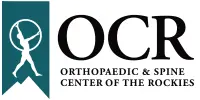If you’re feeling nagging discomfort or sharp pain between your shoulder blades, especially after working at a desk or finishing a workout, you’re not alone.
At Orthopaedic & Spine Center of the Rockies (OCR), many of our patients report upper back tightness, soreness, or stabbing pain. Most often, the cause is mechanical, not serious, but it still needs expert attention to prevent it from becoming chronic.
Common Causes of Shoulder Blade Pain in Active Adults
1. Poor Posture and Sedentary Work
Long hours spent hunched over laptops or phones can overload the muscles between your shoulder blades. This is one of the most common issues we see in patients who work in desk jobs or tech.
2. Muscle Imbalances from Activity
You might strengthen your chest and arms in the gym, but neglect the stabilizing muscles in your mid-back. This creates a push-pull imbalance that strains the rhomboids and trapezius, causing localized soreness.
3. Thoracic Spine Irritation
Issues like minor disc bulges or joint inflammation in the thoracic spine (mid-back) can also radiate pain toward the shoulder blades, especially with twisting, deep breathing, or overhead movement.
Localized Pain: Why One Side Hurts More
Pain isolated to one side, such as upper back pain right side, under the shoulder blade, may stem from:
- A strained rhomboid or trapezius muscle
- Poor posture and muscular imbalance
- Gallbladder or kidney inflammation (especially if accompanied by nausea or flank pain)
Stretch to Relieve Upper Back Tension
Here’s a simple doorway stretch to try at home:
- How to do it: Stand in a doorway, place your arms on the frame at shoulder height, and gently lean forward until you feel a stretch across your chest and front shoulders.
- Why it helps: Releasing tight chest muscles can reduce strain on the upper back muscles, helping with back pain between shoulder blades.
When to See a Physical Therapist vs. a Spine Specialist
| See a Physical Therapist For: | See a Spine Specialist For: |
| Postural or movement-related pain | Pain radiating into arms or chest |
| Muscle tightness or knots | Weakness or tingling in limbs |
| Pain that improves with rest | Persistent or worsening pain |
| Recent activity-related soreness | History of disc or spine issues |
OCR provides both physical therapy and spine care under one roof, ensuring you receive the right treatment based on your diagnosis.
Treatment Options at OCR
Once your physician identifies the cause of your shoulder blade pain, your care plan may include:
- Physical therapy: Strengthening postural muscles, improving spine alignment, and reducing muscular tension
- Manual therapy and massage: To release fascial restrictions or muscular knots.
- PM&R (Physical Medicine & Rehabilitation): OCR’s PM&R specialists focus on non-surgical treatment for complex pain conditions using physical therapy, medication, and targeted procedures like fluoroscopic-guided injections
- Surgical consultation: Rarely needed, but available when structural spine issues do not respond to conservative care
Get Relief from Shoulder Blade Pain—With Local Experts You Trust
Don’t let shoulder blade pain derail your workouts or workdays. Our collaborative team at OCR helps you get to the root cause of your pain and get back to living actively, with customized, non-invasive care options in:
